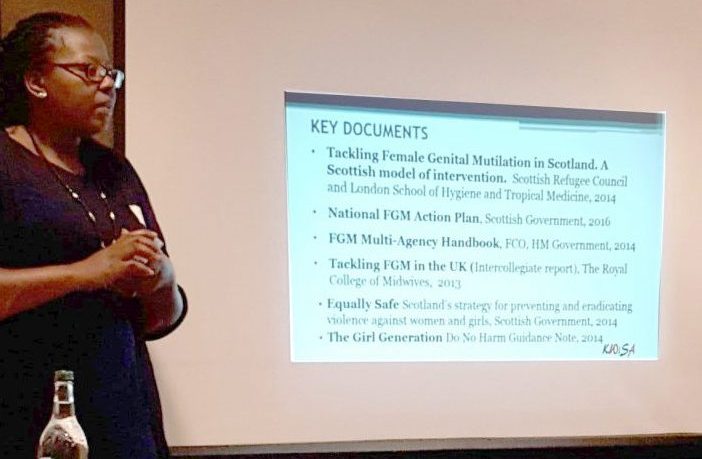Hello, the first workshop our group attended this morning was lead by the woman from KWiSA who visited the Children in Scotland Annual conference today.
They were educating us on the subject of Harmful Traditional Practices (HTPs) going specifically into Female Genital Mutilation (FGM), about how those involved in working with children can indentify children who may be at risk or already affected by FGM which was followed by a group discussion on how to eradicate the issue.
Harmful Tradditional Practices is an umbrella term used to cover all kinds of issues which are embedded within various cultures but are not beneficial to everyone. These practices include bride kidnapping; facial scarring; son preferencing; and of course, our focus of this morning- FGM. FGM is the partial or complete removal of the outer female genitals or other forms of partial mutilation for no medical purposes at all.
FGM is usually carried out upon younger girls between the ages of 0 and around 15 although more refined age brackets are present within different cultures as well as different terms for FGM and reasons. Some reasons for carrying out FGM include bettering marriage prospects, misinterpretation of religious requirements and the preservation of virginity and chastity. Many mothers carry out the procedure on their daughters out of love as often girls who have not undergone FGM are socially excluded from their cultures and communities.
FGM has no health benefits at all but has many implications both short term (such as severe pain and shock, infection both of the surrounding tissue and blood as well as strains and injuries from restraints) and long term issues such as fertility and menstruation difficulties, infections of the uterus, pelvis and vagina as well as pregnancy and childbirth complications.
FGM is mainly practiced in African cultures- in Egypt 91% of girls undergo the procedure and in Somalia as many as 98% of the girls have been subject to FGM- however, as a result of globalisation cultural practices move with the families who practice them. As a result of this, FGM is spreading across the world and while it may not be concentrated in all areas as it is in some areas of Africa it remains a present issue in the lives of young girls.
We were given an example from page 14 of Tackling FGM in Scotland. A Scottish model of intervention, 2014- in 2012 733 children were born to mothers from FGM practicing cultures, of which 363 were girls. The article then goes on to say “we can approximate a minimum additional 700 children per year are born into communities living in Scotland potentially affected by FGM”
The word “potentially” is key here as we cannot assume that any family with a background of an FGM practicing culture is carrying out the procedure on their own daughters. This is why it is particularly hard to identify who is at risk of FGM as it is a very secretive issue and it should be understood that girls who are out through this procedure are not allowed to talk about what has happened to them to anyone other than those who already know therefore we cannot assume that the children affected will be able to come forward and talk about it. Another issue in identifying those at risk is that FGM is often carried out when a child is too young to remember this happening or it is carried out by family members or those close to the family meaning there is a level of trust involved and the young girls do not realise that what is being done to them is wrong.
We were told that when attempting to eradicate the issue of FGM “The question is the approach.” We then partook in a group discussion with all at the talk where we concluded that there needs to be early intervention to educate young girls (those at risk in particular) of this issue then we can break the taboo attitude surrounding it making it easier for those at risk of or affected by FGM to come forward. This is an issue that is too deeply imbedded in cultural practices that we cannot expect communities to change over night but, as with anything, education and awareness are the first steps.



Wow – what a great blog Hazel. Some really interesting statistics in here, especially around the potential impact of young girls in Scotland. Great conclusion ‘education and awareness are the first steps’.